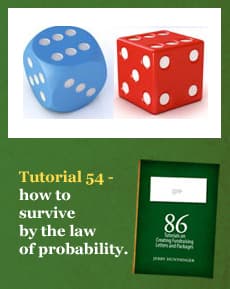Tutorial 54: how to survive by the law of probability
It would be so easy to be successful in direct mail fundraising if all you had to do was come up with one winning package and then send it to your house list for the next 10 years.
- Written by
- Jerry Huntsinger
- Added
- January 06, 2019

But, surviving in the fundraising world is so much more complicated. You have to keep marching ahead and your production schedule usually doesn’t allow you the luxury of testing every package.
And, at the same time, you have to keep increasing net income to meet the challenge of spiralling costs.
If you find yourself in this situation, let me suggest that you try using what I call the ‘law of probability’.
This law is really quite simple. For example, the law of probability says that a real first class stamp almost always guarantees that your mail package will be opened. Or the law of probability says that a personalised letter will usually out pull a printed form letter. Or, often, long copy out pulls short copy, if the appeal is complicated or unknown, while short copy usually wins if the appeal has high visibility or publicity.
Using this principle, you can compile your own set of laws of probability for your organisation, based on your prior experience and examination of what works in similar situations.
What seems to work for you? An emergency? If so, you can’t have a crisis every two weeks, but you can develop a mailing plan that periodically gives your donors the thrill of rescuing you from difficult situations.
Does a premium work for you? If so, give your donors the excitement of a premium now and then so they can hold in their hand a tangible proof of their involvement with your organisation.
If donors tend to respond positively to the format of an extremely simple and plain package, don’t be embarrassed by the lack of glamorous graphics. Instead, turn this situation to your advantage and, when it is time to create the most important appeal of the year, create a plain, simple package and you will have the law of probability on your side.
Another way to state the law of probability is to apply the phrase, ‘give your donors what they want’.
This is because you rarely change your donors. You may be able to educate them to the purposes of your organisation, and you may be able to upgrade them, but you will never change your donor’s lifestyle – either basic demographic patterns or basic psychographic patterns. All you can do is ‘give your donors what they want’.
And, by the way, this is an area where the law of probability will often determine the potential size of your organisation – as indeed it should.
The larger organisations tend to be the most universal in giving donors what they want and the smallest organisations, to protect the uniqueness of their identity and purpose, have a more difficult time finding a donor who wants to receive what the organisation has to offer.
Therefore, the law of probability says that you are most apt to create a winning package for a small organisation if you zero in on those characteristics that make the organisation unique.
And there is one law of probability that, if overlooked, can bring disastrous results. This is the fact that every package must either have: first, a strong theme and purpose; or, two, a strong hook; or, three, both.
If you create a regular appeal without one or both of the above ingredients, then the law of probability is going to cause you extreme embarrassment when the mailing results are in.
But, back to the original problem – just how do you create a winning package again and again for your house list?
One mental attitude you must cultivate to be successful is to be willing to engage in gambling and a high level of risk taking. If you don’t, your mailings are going to quickly become stereotyped, dull, and net income probably won’t keep up with inflation.
Obviously, you can’t write a winning letter every time, because the law of probability is against you. But you can experiment with a new approach, a new format, a new type of personalisation, and, if it works, then later you can use it when you plan subsequent mailings.
Some organisations will test alternate formats with almost every mailing by setting aside a small percentage of their donor list, perhaps five per cent, to receive the test package. This makes the test package quite expensive, because of the small volume involved – but if it results in discovering another winning format for your portfolio of successful appeals, then it is well worth the expense.
Even after you apply all the laws of probability, how can you still be sure you have a winner before you make a final decision?
One general rule I have always relied on is that if the executives of an NGO/charity really like a mailing, based on their own personal preferences, then the mailing will probably be unsuccessful.
On the other hand, if the executives say, ‘I would never read that kind of stuff’, then you may have a winner on your hands.
And you can ensure your success even more if you develop a testing procedure, giving you the opportunity to try a concept on a small portion of your list before you mail the appeal to everyone.
© SOFII Foundation 2010-2014.


 Gwen Chapman is a passionate advocate for donor-centric fundraising. She is a senior consultant with international experience in the non-profit sector in Canada, the United States, the UK and South Africa. She explains the importance to these tutorials
Gwen Chapman is a passionate advocate for donor-centric fundraising. She is a senior consultant with international experience in the non-profit sector in Canada, the United States, the UK and South Africa. She explains the importance to these tutorials 


















